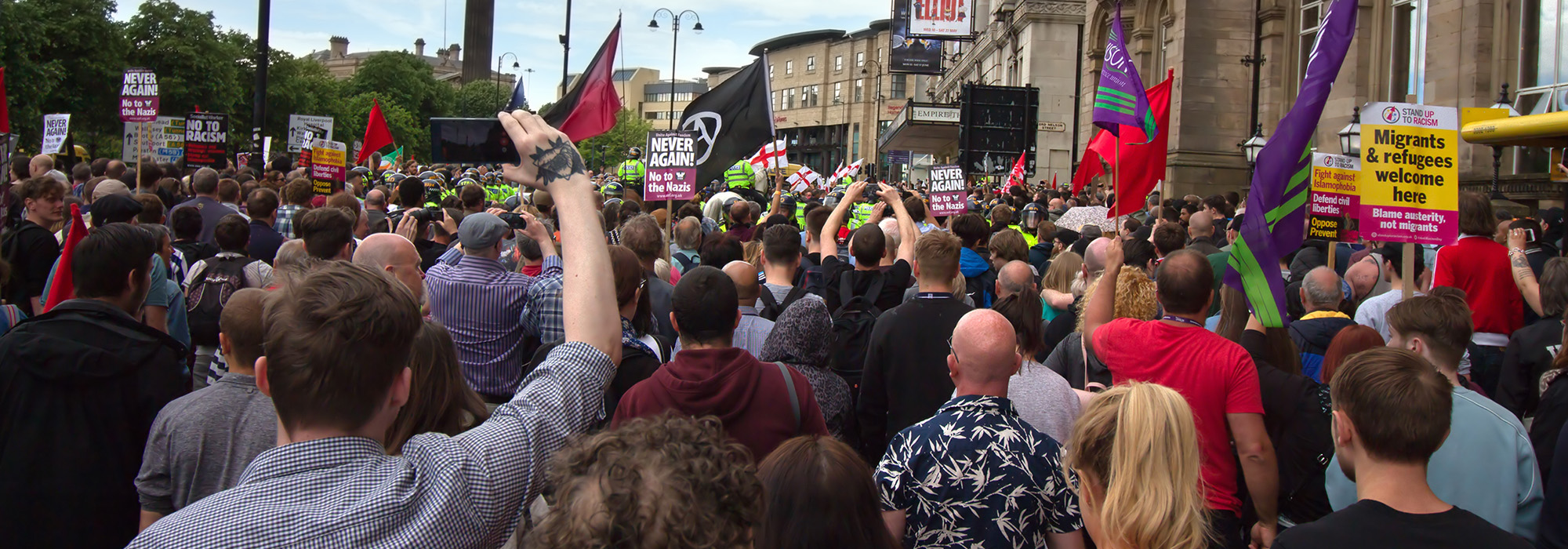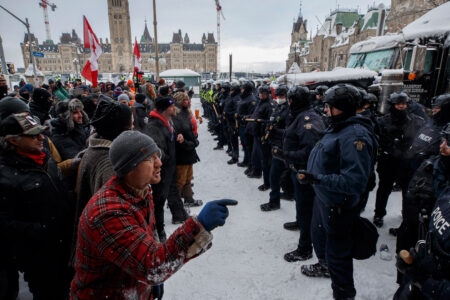
Canada has been caught up in the recent burst of right-wing activism, characterized by xenophobia and bigotry, south of the border. Canadian extremists, apparently energized by Donald Trump’s candidacy, have been more visible since his surprise victory in November. The pamphleting, street patrols, vandalism, violence and, more recently, anti-Muslim and “free speech” rallies lend credence to the speculation that the movement is growing.
In June 2015, with Ryan Scrivens, I published a report on the far-right movement in Canada. At that time, we conservatively estimated that there were just over a hundred active groups in Canada, with memberships ranging from three or four up to a couple of hundred. According to recent media and community agency reports (for example, from the National Council of Canadian Muslims) and judging by the online and offline activities of such hate groups, it is likely that the number of groups has swelled by at least 25 percent in the past year. Recent activities both on the Internet and on the streets reveal that existing groups have added new chapters across the country (for example, the III%ers, the Hammerskins), and new groups have emerged (such as Sons of Odin, Soldiers of Odin, the Proud Boys). Chatter on public social media platforms (Twitter, Facebook) and the growth in dedicated websites (such as Stormfront) also suggest that more people are engaging with the movement. It appears we are in the midst of an alarming qualitative and quantitative shift in right-wing activism in most parts of Canada.
It is not at all certain that policy-makers and practitioners were prepared to deal with the increasing presence of far-right activists. Until very recently, such groups were well off the radar of law enforcement and intelligence. Indeed, one of the key conclusions of our 2015 report was that a weak law enforcement response enabled the movement to sustain itself, especially in rural areas, where officers suggested that “no one knows” the risk because no one was monitoring activity. But even in communities with demonstrable levels of right-wing extremist activity, there was a tendency to deny the presence and threat of these activists in the community. An officer in one Ontario city that is a known hot spot for this activity worried that “we’re not doing enough” to confront the known activists. Another in the same community stated outright that “until something happens, we’re not looking at them.”
Successive threat assessment reports published by federal agencies make little or no mention of the risk posed by right-wing extremists. For example, the Canadian Security Intelligence Service’s 2011-13 public report asserted, “Right-wing extremism has not been as significant a problem in Canada in recent years. Those who hold such extremist views have tended to be isolated and ineffective figures.” The 2016 Public Safety Canada terrorist threat assessment report made no mention of right-wing terrorism. In fact, it included the Islamist-inspired attacks in October 2014, in Saint-Jean-sur-Richelieu and Ottawa, that killed two Armed Forces members but not the right-wing-inspired murders of three RCMP officers in Moncton the same year.
The trends of the past year demand serious reconsideration of how we think about right-wing extremism. The increased visibility and volatility of the movement mean that it is no longer possible to simply ignore the threat it poses. Indeed, we are seeing some renewed focus on resisting hate. Political leaders across the country have taken a stand to challenge right-wing activism. In the face of planned racist and anti-Muslim rallies, municipal leaders like the Mayor of Vancouver have issued calls for anti-racist rallies. Provincially, governments are also condemning acts of hate. In February the Ontario legislature passed a motion that condemns “all forms of hatred, hostility, prejudice, racism and intolerance,” rebukes the “growing tide of anti-Muslim rhetoric and sentiments,” denounces “hate-attacks, threats of violence and hate crimes against people of the Muslim faith” and condemns “all forms of Islamophobia.” That province has also recently enacted a three-year Anti-Racism Strategic Plan, intended to counter systemic racism across the province. In the aftermath of the murders of six people at a Quebec City mosque in January 2017, MP Iqra Khalid introduced a motion calling for the government to “recognize the need to quell the increasing public climate of hate and fear” and “condemn Islamophobia and all forms of systemic racism and religious discrimination.”
However, much of this response has been piecemeal. There does not seem to be a coordinated and sustainable approach to countering organized hate in the long term. In August, Ryan Scrivens and I published a paper examining counter-extremist initiatives that are aimed specifically at right-wing extremism. We encountered two difficulties. First, there has been very little programming for “countering violent extremism,” known as CVE, of any kind in the Canadian context. Consequently, little research has been done on CVE initiatives in Canada. Second, our task was challenging in that, with a handful of exceptions, there has been a clear bias toward countering those who are inspired by radical Islam. Indeed, as noted above, right-wing extremism is barely acknowledged. As a result, there were few identifiable strategies targeting right-wing extremism for us to examine.
Just as the recent resurgence of far-right mobilization requires a serious “rethink” about the threat, it requires us to revisit earlier policy considerations too. One of the most effective legislative tools previously available for countering hate was repealed under the Harper government in 2012. Section 13 of the Canadian Human Rights Act prohibited the communication either by a person or by a group acting in concert of “any matter that is likely to expose a person or persons to hatred or contempt.” The repeal left only relatively weak Criminal Code provisions in place to challenge hate. We would do well to take up with renewed urgency the proposition by Irwin Cotler, an MP at the time, that “the debate we should be having tonight should be regarding how we might reform and structure the human rights commissions to protect freedom of expression while protecting vulnerable individuals and minorities from hate and group vilifying speech rather than committing ourselves to abolishing the entire regime.”
Another by now outdated initiative that we might want to reconsider is A Canada for All: Canada’s Action Plan Against Racism. One of the key pillars of this 2005 federal strategy was countering hate and bias. However, little has been done in the intervening years. Perhaps it is time to bring forward a similar action plan, but with a scope beyond just race. The current right-wing extremist movement takes particular aim at Muslims and immigrants, but its targets generally extend to an array of Others, including women, feminists, LGBTQ communities, even “liberals.”
A broad action plan must also build in concrete, sustainable and accountable mechanisms for specifically challenging right-wing extremism. These mechanisms would be a natural extension of Khalid’s motion, which was symbolic, with no mandated actions attached. Perhaps a promising new federal initiative will provide some impetus for more sustained action: Public Safety Canada now houses the Canada Centre for Community Engagement and Prevention of Violence. With a five-year, $35-million budget, the centre is to “provide leadership on Canada’s response to radicalization to violence, coordinate federal/provincial/territorial and international initiatives, and support community outreach and research.” If this new initiative goes beyond a narrow understanding of “radicalization” to include right-wing extremism among the threats it must address, then we will be in a much stronger position to identify and challenge these hate groups that evoke fear among so many vulnerable communities.
Photo: LIVERPOOL UK. 3rd June 2017. People on the streets of Liverpool protesting against a rally held by Ultra Right Wing group English Defence League. Shutterstock, by kenny 1.
Do you have something to say about the article you just read? Be part of the Policy Options discussion, and send in your own submission. Here is a link on how to do it. | Souhaitez-vous réagir à cet article ? Joignez-vous aux débats d’Options politiques et soumettez-nous votre texte en suivant ces directives.








